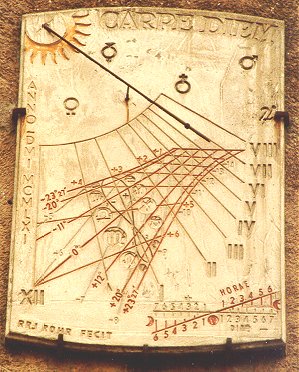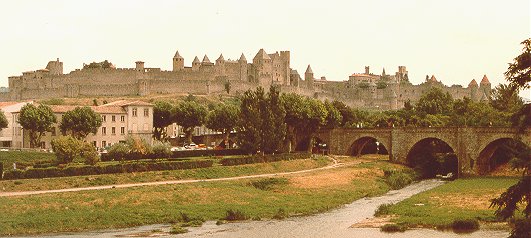
Vertical dials
Place du Château, Carcassonne (Aude, France)

This south-west declining dial with index has an elaborate dial face, from which several data can be read.
Hour lines from XII to VIII (20) hr local time, and an extra line for 12:30.
Analemma around the 1-hour line, with '+' and '-' signs. The parts of the analemma are numbered, indicating approximately: 1=spring, 2=summer, 3=autumn and 4=winter.
Date lines are given per zodiacal month and labeled by the sun's declination in degrees; in between are the signs of the zodiac. Those around the solstices got pinched a bit.
There are two extra sets of lines. The red ones, numbered from +1 to +6, indicate Italian hours, that is, counted from the previous sunset. The rightmost one, not numbered, signals the coming sunset. The hours before that should have been numbered from 23 down to 18, or alternatively from -1 to -6, I think.
The colorless lines are for Babylonian hours, counted from sunrise. They are numbered from -5 to -14. Which should have been from +5 to +14. At the equinox local noon corresponds to 6 hr Babylonian and -6 hr Italian. The four lines intersect neatly in one point (lower left).
The dial can also serve as a 'moon dial', using the graph at the lower right. Proceed as follows:
Read the time indicated by the shadow caused by the moon. Interpret this as nighttime (here: between midnight and 8 am). Estimate how many days before or after full moon it is. Pick this value on the horizontal axis with the colorless numbers, labeled 'DIAE'; before FM at left, after FM at right. Then read the correction in hours from the red, oblique axis labeled 'HORAE'. Before FM: subtract this from the time read earlier; after FM, add this to the reading. Rohr's book has the same graph in its chapter on moon dials. I still don't understand the meaning of the '+' and '-' signs next to the days axis.
Inscription: "Carpe Diem" (Seize the day)
The upper part of the dial face has the symbols of the planets from Mercury to Jupiter, at increasing distances from the sun. See also the table of symbols. The black-and-white picture in Rohr's book suggests that (several of) the colorless lines initially were colored.
Location: 43.2° N, 2.4° E
Design: R.R.J. Rohr
Inauguration: 1961
The 'Cité' of Carcassonne is the largest medieval citadel remaining in Europe. Its perimeter measures a mighty 3 kilometers (2 miles). Its appearance on top of a hill, above the Aude river, is quite impressive. The restoration of the citadel started in the 19th century by Viollet-le-Duc and still continues.

|